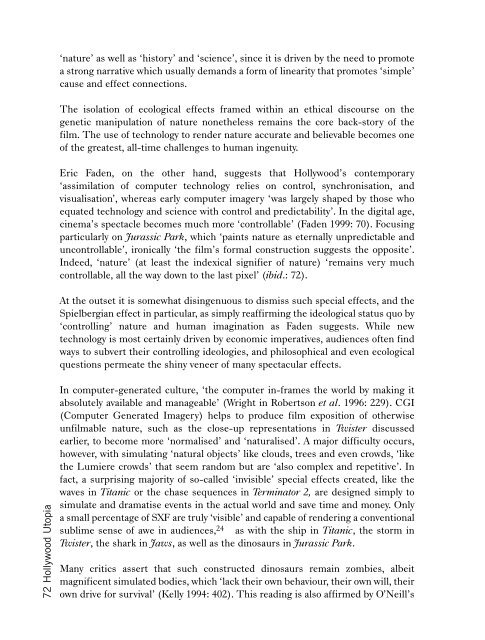Hollywood Utopia
Hollywood Utopia
Hollywood Utopia
Create successful ePaper yourself
Turn your PDF publications into a flip-book with our unique Google optimized e-Paper software.
72 <strong>Hollywood</strong> <strong>Utopia</strong><br />
‘nature’ as well as ‘history’ and ‘science’, since it is driven by the need to promote<br />
a strong narrative which usually demands a form of linearity that promotes ‘simple’<br />
cause and effect connections.<br />
The isolation of ecological effects framed within an ethical discourse on the<br />
genetic manipulation of nature nonetheless remains the core back-story of the<br />
film. The use of technology to render nature accurate and believable becomes one<br />
of the greatest, all-time challenges to human ingenuity.<br />
Eric Faden, on the other hand, suggests that <strong>Hollywood</strong>’s contemporary<br />
‘assimilation of computer technology relies on control, synchronisation, and<br />
visualisation’, whereas early computer imagery ‘was largely shaped by those who<br />
equated technology and science with control and predictability’. In the digital age,<br />
cinema’s spectacle becomes much more ‘controllable’ (Faden 1999: 70). Focusing<br />
particularly on Jurassic Park, which ‘paints nature as eternally unpredictable and<br />
uncontrollable’, ironically ‘the film’s formal construction suggests the opposite’.<br />
Indeed, ‘nature’ (at least the indexical signifier of nature) ‘remains very much<br />
controllable, all the way down to the last pixel’ (ibid.: 72).<br />
At the outset it is somewhat disingenuous to dismiss such special effects, and the<br />
Spielbergian effect in particular, as simply reaffirming the ideological status quo by<br />
‘controlling’ nature and human imagination as Faden suggests. While new<br />
technology is most certainly driven by economic imperatives, audiences often find<br />
ways to subvert their controlling ideologies, and philosophical and even ecological<br />
questions permeate the shiny veneer of many spectacular effects.<br />
In computer-generated culture, ‘the computer in-frames the world by making it<br />
absolutely available and manageable’ (Wright in Robertson et al. 1996: 229). CGI<br />
(Computer Generated Imagery) helps to produce film exposition of otherwise<br />
unfilmable nature, such as the close-up representations in Twister discussed<br />
earlier, to become more ‘normalised’ and ‘naturalised’. A major difficulty occurs,<br />
however, with simulating ‘natural objects’ like clouds, trees and even crowds, ‘like<br />
the Lumiere crowds’ that seem random but are ‘also complex and repetitive’. In<br />
fact, a surprising majority of so-called ‘invisible’ special effects created, like the<br />
waves in Titanic or the chase sequences in Terminator 2, are designed simply to<br />
simulate and dramatise events in the actual world and save time and money. Only<br />
a small percentage of SXF are truly ‘visible’ and capable of rendering a conventional<br />
sublime sense of awe in audiences, 24 as with the ship in Titanic, the storm in<br />
Twister, the shark in Jaws, as well as the dinosaurs in Jurassic Park.<br />
Many critics assert that such constructed dinosaurs remain zombies, albeit<br />
magnificent simulated bodies, which ‘lack their own behaviour, their own will, their<br />
own drive for survival’ (Kelly 1994: 402). This reading is also affirmed by O’Neill’s
















